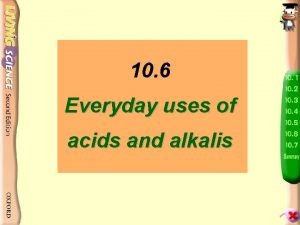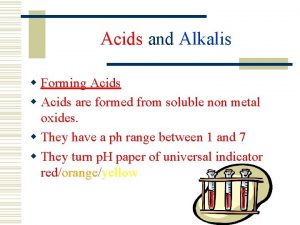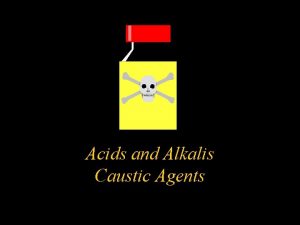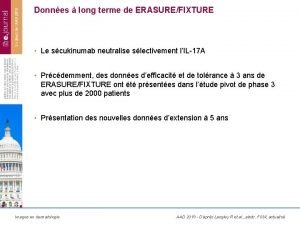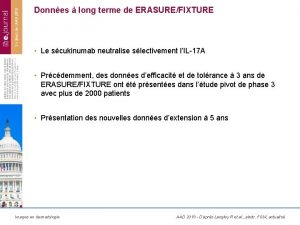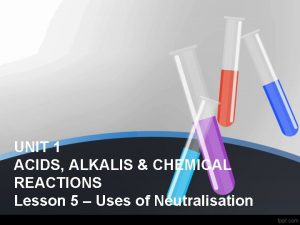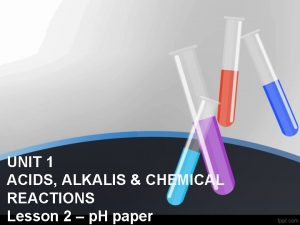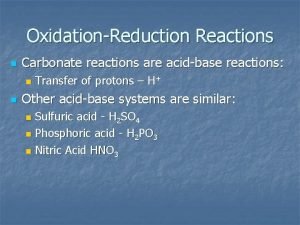Reactions of Alkalis 3 understand that alkalis neutralise










- Slides: 10

Reactions of Alkalis 3. understand that alkalis neutralise acids to make salts 4. recall that soluble hydroxides and carbonates are alkalis (Higher) 5. predict the products of the reactions of soluble hydroxides and carbonates with acids (Higher)

What are alkalis? Alkalis are a substance which have a p. H greater than 7 when dissolved in water. Examples include: Sodium Hydroxide (Na. OH) alkalis Sodium carbonate (Na 2 CO 3) Calcium Hydroxide (Ca(OH)2) Potassium Hydroxide (KOH) acids When an acid reacts with an alkali it forms a salt and water. This is called neutralisation.

More key terms Alkali – substance which when dissolved in water has a p. H greater than 7. Acid – Something which when dissolved gives away hydrogen and has a p. H lower than 7. Salt – When the hydrogen in an acid is replaced with the metal from an alkali. Water – H 2 O Carbon Dioxide – CO 2

Reactions of Alkalis – Hydrochloric Acid Sodium Hydroxide + Hydrochloric acid Sodium Chloride + Water Na. OH + HCl Na. Cl + H 2 O In this reaction the hydrogen from the acid reacts with the OH group from the alkali to form water. The hydrogen from the acid is replaced by the sodium from the hydroxide to form a salt, sodium chloride. Hydrochloric acid ALWAYS forms Chloride salts. NB – Chemists usually use red to denote oxygen and white to denote hydrogen

Reactions of Alkalis – Hydrochloric Acid Sodium Carbonate + Hydrochloric acid Sodium Chloride + Carbon Dioxide + Water Na 2 CO 3 + 2 HCl 2 Na. Cl + CO 2 + H 2 O In this reaction the hydrogen from the acid reacts with the CO 3 group from the carbonate to form water and carbon dioxide. The hydrogen from the acid is replaced by the sodium from the carbonate to form a salt, sodium chloride. Hydrochloric acid ALWAYS forms Chloride salts. NB – Chemists usually use red to denote oxygen and white to denote hydrogen

Your Turn Complete the following word equations Lithium Hydroxide + Hydrochloric Acid Lithium Chloride + Water Potassium Carbonate + Hydrochloric acid Potassium Chloride + Carbon Dioxide + Water Bonus Question: How could you tell by looking at the reaction whether the acid was reacting with a carbonate or a hydroxide? Answer If it was reacting with a carbonate it would fizz, effervesce.

Reactions of Alkalis – Sulphuric Acid Sodium Hydroxide + Sulphuric acid 2 Na. OH + H 2 SO 4 Sodium Sulphate + Water This is the sulphate group, SO 4. Note this stays together. Na in 2 SO 4 the reaction + 2 H 2 O In this reaction the hydrogen from the acid reacts with the OH group from the alkali to form water. The hydrogen from the acid is replaced by the sodium from the hydroxide to form a salt, sodium sulphate. Sulphuric acid ALWAYS forms sulphate salts. NB – Chemists usually use red to denote oxygen and white to denote hydrogen

Reactions of Alkalis – Sulphuric Acid Sodium Carbonate + Sulphuric acid Sodium Sulphate + Carbon Dioxide + Water Na 2 CO 3 + H 2 SO 4 Na 2 SO 4 + CO 2 + H 2 O In this reaction the hydrogen from the acid reacts with the CO 3 group from the carbonate to form water and carbon dioxide. The hydrogen from the acid is replaced by the sodium from the carbonate to form a salt, sodium sulphate. Sulphuric acid ALWAYS forms sulphate salts. NB – Chemists usually use red to denote oxygen, white to denote hydrogen and black to denote carbon

Your turn Complete the following word equations Potassium Hydroxide + Sulphuric Acid Potassium Sulphate + Water Potassium Carbonate + Sulphuric acid Potassium Sulphate+ Carbon Dioxide + Water NB – You will not need to write symbol equations till the next Chemistry unit.

Exam Questions Potassium chloride Carbon Dioxide
 9 section perm wind technique
9 section perm wind technique To understand recursion you must understand recursion
To understand recursion you must understand recursion Salt preparation methods
Salt preparation methods Everyday alkalis
Everyday alkalis Dangerous alkalis
Dangerous alkalis Alkali examples
Alkali examples Section 2 reinforcement classifying chemical reactions
Section 2 reinforcement classifying chemical reactions Chemistry unit 5 reactions balancing reactions worksheet
Chemistry unit 5 reactions balancing reactions worksheet Basic redox reactions
Basic redox reactions Section 2 classifying chemical reactions worksheet answers
Section 2 classifying chemical reactions worksheet answers Types of reactions
Types of reactions



